 “There it is. That’s Africa. Namibia.”
“There it is. That’s Africa. Namibia.”
Such was my welcome to Africa by my “cousin” Jonathan Durand, whose Polish grandmother also grew up in Tanzania. We have learned through our travels that we third-generationers are all considered family.
My first real glimpse of the continent from the airplane window brought a feeling of inner calm that quickly turned into excitement. This was surely not at all the first view of Africa that our babcias (grandmothers) had seen, given that they arrived by boat in 1943. But the excitement of arriving in Africa was possibly on par…
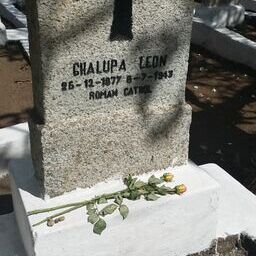
Amanda’s family grave
When asked what was the purpose of our Fall 2015 travel to Africa, I find myself going through a varied list of experiences. Of course there is the professional component: Jonathan travelled there as a filmmaker with funding from Telefilm Canada to shoot for his documentary Memory Is Our Homeland. I was there to assist and to do work related to my PhD research on how trauma survivors rebuild their lives, how safe spaces are remembered and celebrated, and to make both academic and community contacts. In this context, we had an opportunity to give presentations in Pretoria at the 2nd Annual Polish South Africa Conference and to attend the All Saints’ Day ceremony at the Polish cemetery in Tengeru, Tanzania, the site of our families’ former refugee camp.
Personally, we had the opportunity to meet countless fascinating people and explore cities, towns, villages, and the landscape in a diversity of African settings.
Emotionally, we were going home to the enchanted land where monkeys dangled from branches as freely as the Polish children had once swung on lianas across sand-cliffed streams. We were going back to the shared memories of hundreds of Polish people from around the world that we have met over the years who identify themselves as “Afrykanczycy”, the Africans. And of course, we were returning to our own childhood memories. We were breathing life into narratives that, as we had discovered through our interactions, were incomprehensible to many in both the general public and to academic audiences. Not much is known about Siberia, the Soviet labour camps, and General Anders’ Army, less still about refugee camps that sounded much too exotic and much too much fun for refugee children.
We touched down at night, and woke up to a city filled with thousands of jacarandas in full bloom which, to our luck, lasted longer than usual that year. At dusk, they stood out against a backdrop of red haze sunsets which I came to learn only Africa can offer.
It wasn’t long before the action started, as we visited various Polish and South African memory sites in and around the city. Stefan Szewczuk, President of the Polish Association of Siberian Deportees in South Africa and organizer of the 2nd Annual Polish South Africa conference, was our go-to guy while in Jo’Burg, and kindly gave us personalized visits with an “Afrykanczyk” spin. At the conference, which was attended by multiple generations, we soon found ourselves in a scenario that we had experienced before…
“When we met up with people at the conference, it was fascinating to be able to feel part of a shared community,” Jonathan recalls. “Even if we’re separated by an ocean, and it has been more than 60 years since the last Polish refugee camp in Africa closed, we have a connection that transcends the nationalities taken on since 1952. The South African grandchildren of survivors feel akin to cousins: despite our national differences, we share some of the same past and present.”
These sentiments were only magnified as our travels continued. It must come as no surprise that we were promptly invited to the homes of our “extended family” that we had met at the conference. We were set to visit Pani Aldona Dusinski, whose father Stanisław Znatowicz had been the principal of an agricultural college that he helped found on the site of the Tengeru refugee camp. Because her father was both one of the central educators at Tengeru and a meticulously organized amateur photographer, Pani Donia has dozens of photo albums and boxes of photos from Tanzania from the 1940s to 70s.
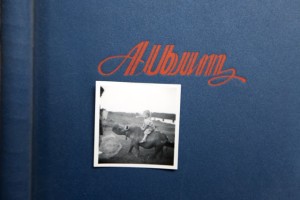
Pani Donia’s daughter on a baby rhino
The boxes had been stored away for years, and she had just started going through them the week before we arrived. Even her grandchildren had never seen these photos that we all discovered together on film. One of the photos immediately stood out: a small Polish girl, Pani Donia’s daughter, riding a baby rhinoceros. Jonathan took a photo of the photo, and upon his return to Montreal, stumbled upon a British archival newsreel from East Africa, shot in 1961, of a young, blonde girl riding a baby rhinoceros. Almost the exact same image, separated by just a couple of years, close enough that they looked like the same memory…
Many evenings were enjoyed with the Szewczuk family, whose home is shared by three generations allowing for special moments and memories to be shared. During one of these evenings, Jonathan was interviewing Pan Jan Szewczuk and his granddaughter in the family garden. Pan Szewczuk was one of the Polish orphans sent to the Oudtshoorn refugee camp. He stayed in South Africa when the camp closed, building a career as a mining foreman. Sitting together with her grandfather, Alekzandra Szewczuk listened raptly to his stories. When we asked her what they meant to her, she said that while she may take them for granted now, she knew that these stories would become even more important to her one day.
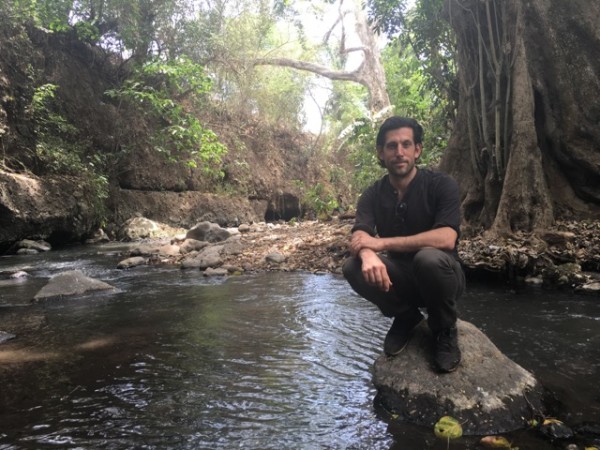
Jonathan at a river where Polish kids once played
“Interviewing a couple of the survivors with their grandparents helped me to see how the same sorts of stories are told in South Africa as in Canada,” Jonathan shares. “Maybe without realizing it, our South African, and Canadian, and British, and New Zealand, and Australian babcias and dziadzias, in telling us all the same sorts of stories, gave us a shared past that turns quickly into a sense of community as soon as we, the grandchildren of the survivors, get together to speak.”
Going our separate ways for a few days, Jonathan traveled to Zambia with Rachael Jarosh, a Polish-American lawyer and author writing a book on her family’s time in a refugee camp in Abercorn, while I took the train to Cape Town to visit more “family” that we had met at the conference. We then reconvened in Dar es Salaam, Tanzania, and headed West towards Arusha. Exploring the area, we decided to walk from the “bus stop” to the cemetery, not really knowing exactly where it was but up for our own adventure.
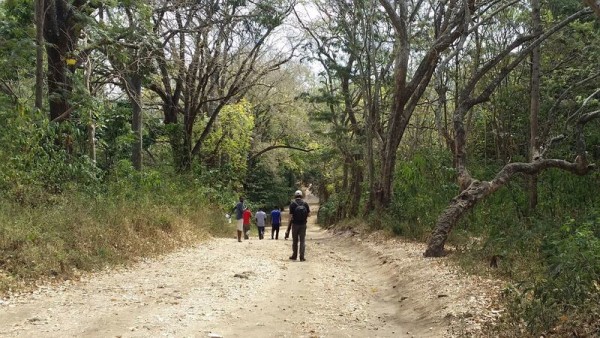
On the road to Tengeru
After walking through the cabbage patch and rice fields beside the main road, hanging a left at the banana trees, pausing to film bees in a tree, heading down the bank, slipping through the river where our grandparents probably used to enjoy their days, crawling up a 6 metre wall of sand and clawing at roots and the odd rock into someone’s backyard, who emerged looking down at us and whom we greeted in rehearsed Swahili, “Jambo! Kipolishi makaburi? Asante sana!” (Hello! Polish Cemetery? Thank you very much!”), which was good enough for our new guide to lead us past an angry goat and through a swamp, arriving out of breath and muddy, but happy, at the Cemetery of Polish War Refugees in Tengeru, Tanzania. Here we were greeted by Simon, the son of the original cemetery caretaker, who is now the keeper of the Polish-Tanzanian story on the site of the former refugee camp.
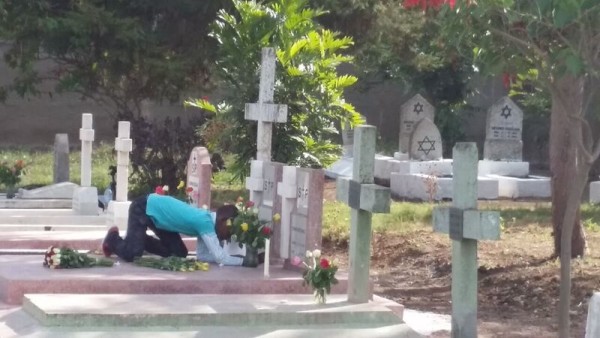
Simon’s son tending a Polish grave
Reflecting on our experiences at the cemetery, Jonathan thinks that “for all of the survivors that we have been fortunate to meet, and who have taught us about our history, it goes without saying that thousands of others did not survive the deportations or the African refugee camps. The last traces of their lives are in the cemeteries where they are buried, like in Tanzania, where the unexpected presence of Polish graves tells a story in itself. Through people like Simon, caretaker of the Polish cemetery in Tengeru, the people who are buried there still have stories to tell.”
Who will tell these stories, and how?
Where else can versions of this story be found today?
When we returned to the cemetery a few days later to film and participate in the All Saints’ Day service, we were joined by Annabelle Augustyn, a third-generationer from Connecticut who was volunteering in the area. Her Babcia organizes yearly reunions in her home for the Afrykanczycy of the North East.
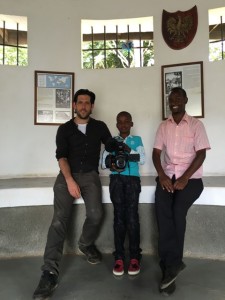
Jonathan with Simon’s sons
We also met Simon’s sons, the eldest of whom hopes to study in Poland, which I imagine is not a pursuit of the average young man in rural Tanzania. Together, we share an important international “third-generation” connection, all with African roots that at least in part are buried in this cemetery, to the left of the banana trees and across the stream…
There is an undeniable tragic and traumatic component to this history. But when we “African cousins” meet, much like the Afrykanczycy at their reunions, we immediately celebrate! We “get” each other. And we have stories of our own to tell.
But that’s another story for another time…
•••
Do you have a third-generation Africa connection? Or perhaps a connection to India, Mexico, Lebanon, Iran, Italy, New Zealand, or Australia…? Let’s keep in touch! Various materials and upcoming events are to be shared. Please email me at amanda.a.chalupa at gmail.com , and be sure to like the Cosmopolitan Review Facebook Page for more articles about our connection.
Watch the “Memory Is Our Homeland” trailer
CR
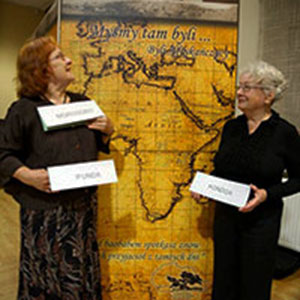


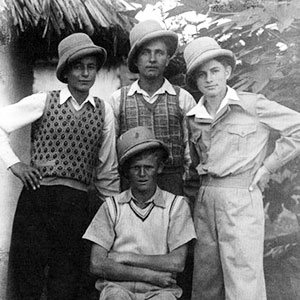
Pingback: Welcome to Spring 2016!
My mother and her sisters were in Kidugala Camp in Tanzxania, and many family friends (who later ended up in Canada) were in Tengeru, so I share your feelings about the connection that we all have.
Thank you for sharing your experiences in Africa.
There are still,as I am,people around of original generation that lived through those days.Good to hear of continuing interest in our history.If I can be of any assistance to your PhD thesis don’t hesitate to get in touch.
I wonder if any South African Polish remember Wojtek the Soldier Bear,? If they do watch this talk by someone who remember him
https://www.youtube.com/watch?v=WR2kKw3kQEA
and join the Facebook Group
https://www.facebook.com/groups/wojtekthesoldierbear